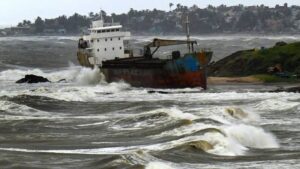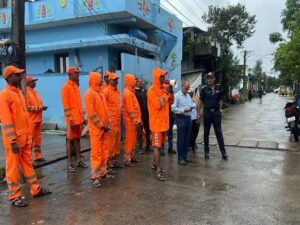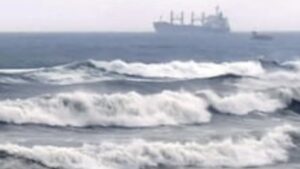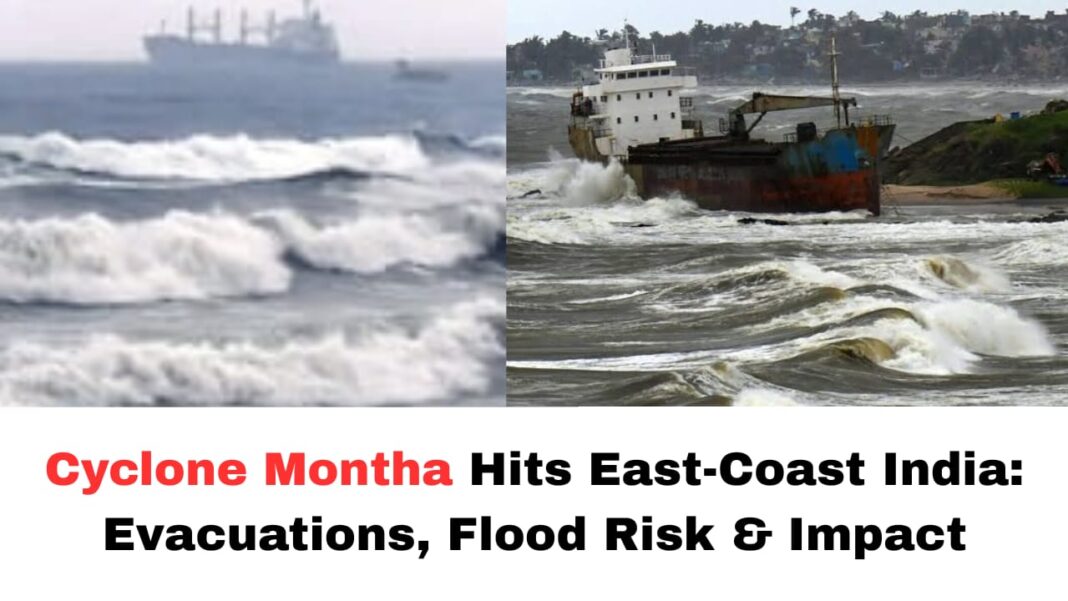Digital News Guru Environment Desk:
Cyclone Montha Makes Landfall on Andhra Coast
India’s east coast is facing a major weather event as Cyclone Montha, now classified as a Severe Cyclonic Storm, has begun to make landfall in the state of Andhra Pradesh and is bearing down on vulnerable coastal and inland regions with heavy winds, torrential rain and heightened risk of flooding.
Timing, Path & Intensity
The India Meteorological Department (IMD) states that Montha is currently moving north-northwestwards across the west-central Bay of Bengal at around 12–15 km/h. It is expected to cross the coast between Machilipatnam and Kalingapatnam (near Kakinada) in Andhra Pradesh during the evening or night of 28 October 2025.

Wind speeds at landfall are estimated in the range of 90–100 km/h, with gusts potentially reaching up to 110 km/h. The landfall process is expected to continue for three to four hours.
Areas Likely to Be Impacted
Coastal districts of Andhra Pradesh like Kakinada, East & West Godavari, Krishna, and Visakhapatnam are among the primary zones at risk. Inland districts including Rayalaseema and parts of Telangana, Odisha, and Chhattisgarh are also on alert for heavy rain and wind changes.
Neighbouring state Odisha has opened more than 2,000 disaster relief centres in the eight southern districts likely to be affected.
Preparations & Response
Authorities across affected states have mobilised emergency personnel, relief camps and evacuation procedures:
- In Andhra Pradesh, nearly 50,000 people have been moved into relief camps in vulnerable zones, as per Reuters.
- In Guntur district alone, 92 relief camps have been activated and approximately 5,983 residents evacuated from high-risk areas.
- The rail network has been disrupted — more than 120 train services cancelled or rescheduled in the South Central Railway zone.
- Air travel was impacted with over 35 flights cancelled between Telangana and Andhra Pradesh due to Montha.
- The IMD issued red alerts (highest level) for 19 districts in Andhra Pradesh.

Early Impacts Noted
- One fatality has been reported in Andhra Pradesh’s Konaseema/West Godavari region where a tree fell on a house during strong winds.
- Sea-conditions are extremely dangerous: waves and storm surge causing coastal flooding and damage to beachside roads (for example in Uppada near Kakinada).
- Crops in Andhra Pradesh have also been hit: 38,000 hectares of standing crops and 1.38 lakh hectares of horticulture reportedly damaged in some areas.
Risks & What to Expect
- Wind damage: With gusts up to ~110 km/h, expect trees uprooted, power lines knocked down, structural damage to weak or temporary buildings.
- Heavy rainfall & flooding: The storm is expected to produce extremely heavy rainfall in isolated places in coastal Andhra, Rayalaseema, and parts of Odisha and Telangana — leading to surface flooding, river overflow, urban inundation.
- Storm surge & high seas: Coastal zones face risk of sea water intrusion, wave-breach, coastal road damage. Authorities have already warned fishermen and restricted sea access.
- Secondary hazards: Landslides in hilly terrain, disruption of transport and power, damage to crops which may have long-term economic effects.
- Climate-context: Meteorologists say storms of this nature are increasing in intensity due to warmer oceans and climate change.
What You Should Do
If you are in or know people in the affected zone, here are precautions:
- Avoid staying in low-lying, flood-prone, or structurally weak shelters. Move to higher ground or relief centres if advised.
- Stay indoors while the storm is active. Avoid going near the sea-shore, beach roads or under trees.
- Charge mobile devices; keep emergency contact numbers handy.

- Avoid travel unless absolutely necessary; roads may be blocked and transport disrupted.
- Monitor official updates: IMD bulletins, state government advisories, local district/distress control rooms.
- If living in coastal or river-adjacent areas, be prepared for possible evacuation.
- Secure loose objects around home; unplug sensitive electronics; have a contingency plan for power cuts.
The Bigger Picture
Cyclone Montha serves as a reminder of the vulnerability of India’s east-coast to severe cyclonic storms, and the growing challenge posed by climate change. With sea surface temperatures rising, storms derive greater energy and can intensify faster. As India braces for these events more often, disaster preparedness — both structural and community-based — is becoming increasingly crucial.
In Summary
Cyclone Montha is a serious weather event making landfall around Kakinada in Andhra Pradesh with winds up to ~110 km/h and heavy rainfall expected in the next 12-24 hours. With tens of thousands already evacuated, transport and infrastructure disrupted and the coast on high alert, the storm is testing disaster-management readiness. The coming hours will be critical: how the system evolves, whether rainfall intensifies, and whether sea-surge or inland flooding result in significant damage. Authorities and residents both will need to remain vigilant.
You May Also Read: Bad Girl OTT Release: Stream the Tamil Drama on JioHotstar from Nov 4








